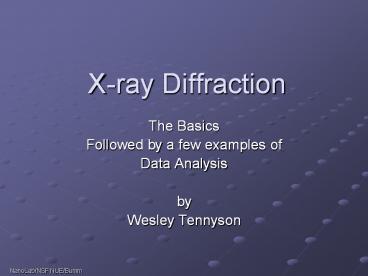X-ray Diffraction PowerPoint PPT Presentation
Title: X-ray Diffraction
1
X-ray Diffraction
- The Basics
- Followed by a few examples of
- Data Analysis
- by
- Wesley Tennyson
NanoLab/NSF NUE/Bumm
2
X-ray Diffraction
- Braggs Law
- Lattice Constants
- Laue Conditions
- ? - 2? Scan
- Scherrers Formula
- Data Analysis Examples
3
Braggs Law
- n? 2 d sin ?
- Constructive interference only occurs for certain
?s correlating to a (hkl) plane, specifically
when the path difference is equal to n
wavelengths.
4
Bragg conditions
- The diffraction condition can be written in
vector form - 2kG G2 0
- k - is the incident wave vector
- k - is the reflected wave vector
- G - is a reciprocal lattice vector such that
where - G ?k k - k
- the diffraction condition is met
5
Lattice Constants
- The distance between planes of atoms is
- d(hkl) 2p / G
- Since G can be written as
- G 2p/a (hb1 kb2 lb3)
- Substitute in G
- d(hkl) a / (h2 k2 l2)(1/2)
- Or
- a d (h2 k2 l2)(1/2)
- a is the spacing between nearest neighbors
6
Laue Conditions
- a1?k 2p?1 a2?k 2p?2
- a3?k 2p?3
- Each of the above describes a cone in reciprocal
space about the lattice vectors a1, a2, and a3. - the ?i are integers
- When a reciprocal lattice point intersects this
cone the diffraction condition is met, this is
generally called the Ewald sphere.
7
Summary of Bragg Laue
- When a diffraction condition is met there can be
a reflected X-ray - Extra atoms in the basis can suppress reflections
- Three variables ?, ?, and d
- ? is known
- ? is measured in the experiment (2?)
- d is calculated
- From the planes (hkl)
- a is calculated
8
? - 2? Scan
The ? - 2? scan maintains these angles with the
sample, detector and X-ray source
Normal to surface
Only planes of atoms that share this normal will
be seen in the ? - 2? Scan
9
? - 2? Scan
- The incident X-rays may reflect in many
directions but will only be measured at one
location so we will require that - Angle of incidence (?i) Angle of reflection
(?r) - This is done by moving the detector twice as fast
in ? as the source. So, only where ?i ?r is the
intensity of the reflect wave (counts of photons)
measured.
10
? - 2? Scan
11
Smaller Crystals Produce Broader XRD Peaks
12
Scherrers Formula
- t thickness of crystallite
- K constant dependent on crystallite shape
(0.89) - l x-ray wavelength
- B FWHM (full width at half max) or integral
breadth - qB Bragg Angle
13
Scherrers Formula
- What is B?
- B (2? High) (2? Low)
- B is the difference in angles at half max
Peak
2? high
2? low
Noise
14
When to Use Scherrers Formula
- Crystallite size lt1000 Å
- Peak broadening by other factors
- Causes of broadening
- Size
- Strain
- Instrument
- If breadth consistent for each peak then assured
broadening due to crystallite size - K depends on definition of t and B
- Within 20-30 accuracy at best
Sherrers Formula References Corman, D.
Scherrers Formula Using XRD to Determine
Average Diameter of Nanocrystals.
15
Data Analysis
- Plot the data (2? vs. Counts)
- Determine the Bragg Angles for the peaks
- Calculate d and a for each peak
- Apply Scherrers Formula to the peaks
16
Bragg Example
17
Bragg Example
- d ? / (2 Sin ?B) ? 1.54 ?
- 1.54 ? / ( 2 Sin ( 38.3 / 2 ) )
- 2.35 ?
- Simple Right!
18
Scherrers Example
19
Scherrers Example
t 0.89? / (B Cos ?B) ? 1.54 ?
0.891.54 ? / ( 0.00174 Cos (98.25/ 2 ) )
1200 ? B (98.3 - 98.2)p/180 0.00174 Simple
Right!

